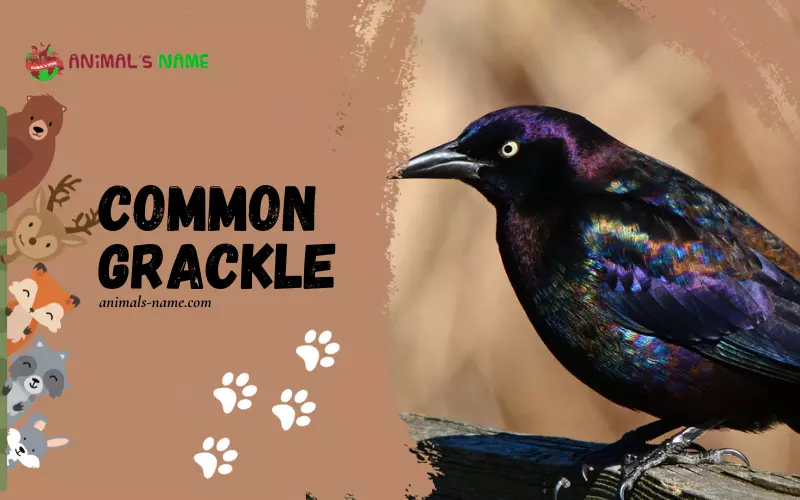The Common Grackle is a fascinating bird that can be found throughout North America. Its history dates back thousands of years and has become a familiar sight in many urban areas. In this blog post, we will explore this remarkable bird’s history, facts, size, habitat, and classification.
The Common Grackle, also known as Quiscalus quiscula, belongs to the family Icteridae. It is a medium-sized bird with a long tail and sleek black feathers. The males have striking iridescent feathers that shimmer with purple, blue, and green shades. On the other hand, females have a more subdued appearance with dark brown plumage.
These birds are highly adaptable and can thrive in various habitats, including woodlands, meadows, and cities. They can often be seen perched on trees or foraging on the ground for insects, grains, and small vertebrates. The Common Grackle is known for its loud and raucous calls, which can be heard from afar.
The Common Grackle is a captivating bird with a rich history and unique characteristics. Its ability to survive in diverse habitats and its distinct appearance make it an exciting subject. By learning more about the Common Grackle, we can appreciate the beauty and diversity of our local bird species. If you want to explore more about the animal kingdom, don’t forget to check out our extensive article featuring 155+ animal names.
History of Common Grackle
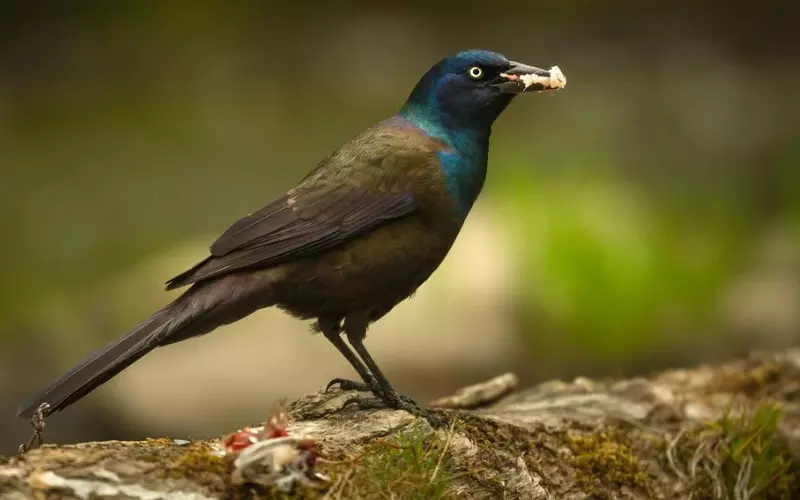
The Common Grackle bird is a fascinating creature with a rich history. These birds have been around for a long time, making them an integral part of our natural world. They can be found in various parts of North America, from the east coast to the central areas of the continent.
In the early days, Native Americans admired Common Grackles and considered them sacred. They saw these birds as messengers from the spirit world, bringing wisdom and knowledge. These beliefs were passed down through generations, making the Common Grackle an essential symbol in their culture.
As settlers arrived in North America, they were captivated by the Common Grackle. These birds were seen as a sign of good luck and were often welcomed in towns and villages. People would leave food out for them, inviting them to stay and protect their crops from insects. This symbiotic relationship between humans and Common Grackles continues today.
Over time, the population of Common Grackles has fluctuated. They have adapted to changes in their environment and expanded their range. They are brilliant birds, known for their distinct vocalizations and impressive problem-solving skills. Common Grackles have also become adaptable to urban areas, finding food and shelter in cities and towns.
The Common Grackle bird has a long and storied history in North America. From their sacred status among Native Americans to their beneficial relationship with settlers, these birds have been valued for their beauty and intelligence. Today, they continue to thrive across different habitats, reminding us of the importance of coexisting with nature.
Importance of Common Grackle

The Common Grackle bird is essential for many reasons. First, these birds help control insect populations. They eat a lot of harmful insects, such as grasshoppers and beetles. This is good for us because fewer bugs eat our crops and gardens. So, the Common Grackle is like a natural exterminator.
Second, these birds play a vital role in seed dispersal. They love eating fruits and berries; when they do, the seeds pass through their digestive system. Later, when they poop, they spread these seeds to different areas. This helps plants and trees grow in new places, maintaining a balanced ecosystem.
Lastly, the Common Grackle is an excellent indicator of the health of our environment. These birds are highly adaptable and can survive in a variety of habitats. If their population is flourishing, it means that our environment is healthy. However, if their numbers start to decline, it could be a sign that something is wrong, like pollution or habitat destruction.
The Common Grackle bird is essential for controlling insects, helping plants grow, and indicating the health of our environment. It is fascinating to see how these birds contribute to the balance of nature.
Amazing Facts About Common Grackle
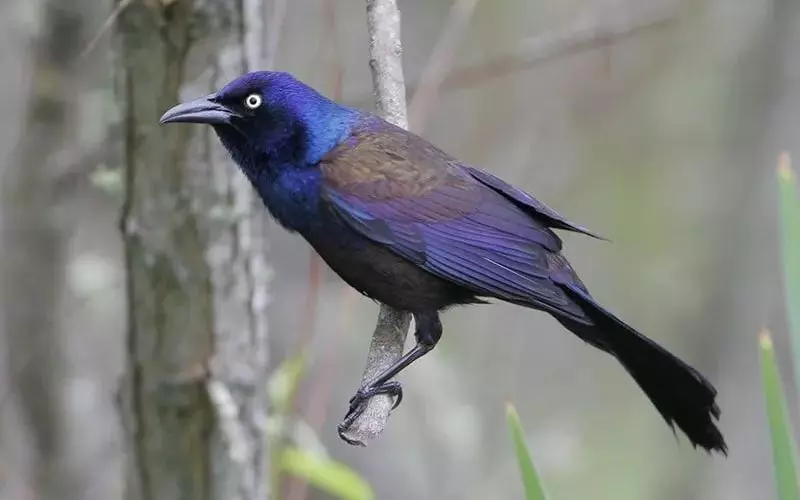
1. The common grackle bird is a blackbird species found throughout North America.
2. They have a long tail, a distinctive keel-shaped beak, and bright yellow eyes.
3. Male common grackles are more significant than females, measuring about 13-14 inches long.
4. These birds have a glossy black plumage that may appear iridescent under sunlight.
5. They are known for their loud and varied vocalizations, including calls, squawks, and whistles.
6. Common grackles are opportunistic eaters with a diverse diet, including insects, seeds, fruits, and even small vertebrates.
7. Their intelligence and adaptability enable them to thrive in various habitats, from urban areas to forests and wetlands.
8. Common grackles often gather in large flocks, displaying highly synchronized movements during their impressive aerial displays.
9. During the breeding season, male grackles use their vibrant plumage to attract mates, performing elaborate courtship displays.
10. Females lay 3-7 eggs in a cup-shaped nest constructed from twigs, grass, and mud. The nests are often found in trees, shrubs, or man-made structures.
11. Both parents are responsible for incubating the eggs and caring for the nestlings.
12. Common grackles are known to be resourceful and have been observed using tools, such as twigs or blades of grass, to extract food from hard-to-reach places.
13. Some may consider them pests due to their fondness for raiding crops, but they also provide ecological benefits by controlling insect populations.
14. They are highly adaptable to human environments and can often be seen foraging for food in parks, parking lots, and garbage bins.
15. The lifespan of a common grackle is typically around 8-15 years, although some individuals have been known to live up to 23 years in captivity.
Can we keep Common Grackle as our Pet?
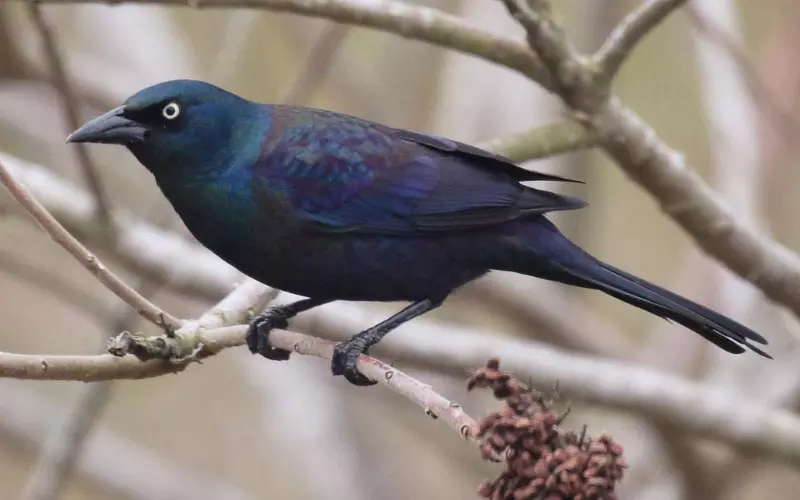
Keeping a Common Grackle bird as a pet is not allowed. These birds are unsuitable for domestication and should not be kept in captivity. Common Grackles are wild birds that belong in their natural habitats, such as forests, meadows, and wetlands.
Common Grackles are not extinct. However, any discussion regarding the possibility of keeping them as pets is irrelevant because it is against the law and not recommended. Although they may appear attractive with their iridescent feathers and unique calls, these birds have specific needs that cannot be met in a home environment.
When it comes to keeping pets, it is vital to consider the well-being and conservation of the species. In the case of the Common Grackle, it is crucial to let them live freely in their natural habitats and to respect their role in the ecosystem. Allowing them to roam and breed in the wild ensures their survival and contributes to our environment’s overall balance and diversity.
Common Grackle birds cannot be kept as pets. Letting them thrive in their natural habitats rather than keeping them in captivity is best. As responsible individuals, we should appreciate the beauty of these birds from a distance and encourage their protection and conservation in the wild.
Size of Common Grackle
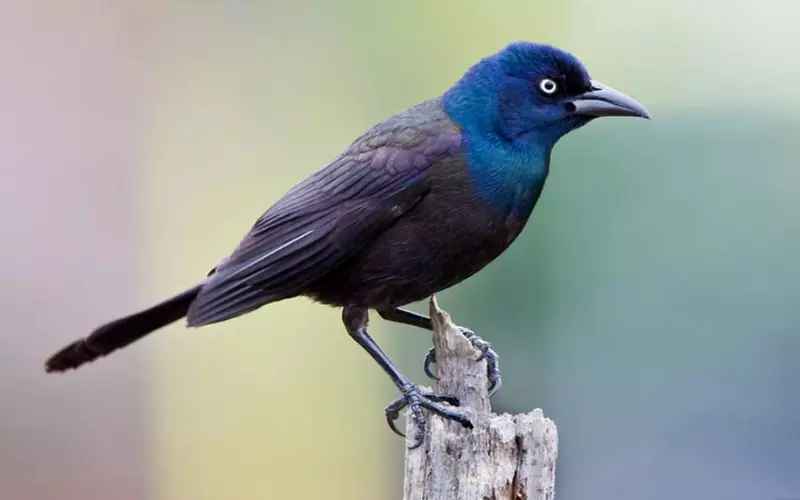
The Common Grackle is a medium-sized bird found in North America. It measures about 12 to 13 inches long, with a wingspan of around 17 to 18 inches. This makes it slightly larger than a typical robin or blackbird. It has a long tail, stout bill, and strong legs.
One way to identify the Common Grackle is by its shiny black plumage. The male has a purplish-blue iridescence on its head and body, which appears more prominent in bright sunlight. The female, on the other hand, has a duller brownish-black colour. Both genders have yellow eyes and a long, pointed bill.
The Common Grackle is known for its noisy nature, especially during the breeding season. They often gather in large flocks and can be pretty loud and boisterous. Despite their size, Common Grackles are skilful flyers capable of soaring through the air with agility. They are also highly adaptable and can live in various habitats, including forests, farmlands, and suburban areas.
The Common Grackle is a medium-sized bird with a length of around 12 to 13 inches and a wingspan of approximately 17 to 18 inches. It has shiny black plumage with a purplish-blue iridescence on the male, while the female has a duller brownish-black colour. These birds are known for their noisy nature and are found in different habitats across North America.
Habitat of Common Grackle
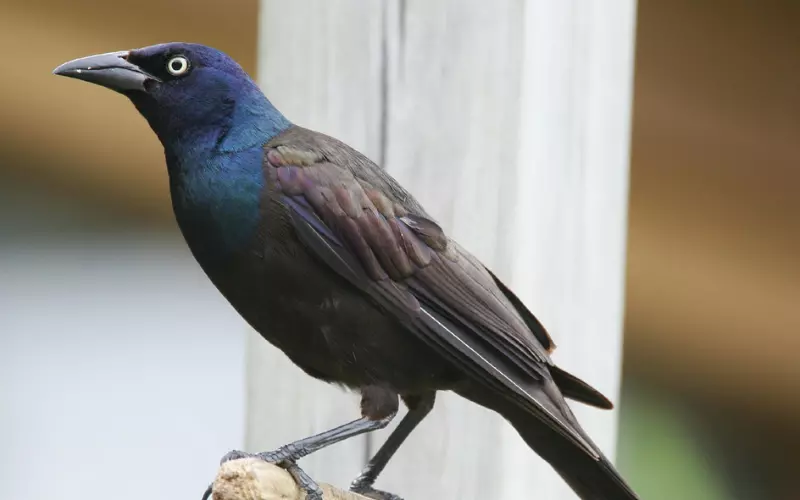
The habitat of the common grackle bird is quite diverse, meaning they can live in many different places. These birds can be found in North America, from the southern parts of Canada down to Central America. They like to live in areas with plenty of trees and open spaces, such as forests, meadows, and suburban neighbourhoods.
One of the main reasons why common grackles prefer these types of habitats is because they provide them with lots of food. Grackles like to eat various things, including insects, fruits, seeds, and even small animals like mice and frogs. Living in areas with many trees and open spaces allows them to find these foods easily and survive.
In addition to their food preferences, common grackles also like to live in habitats with plenty of places to build their nests. They usually build their nests in trees but can also use shrubs or man-made objects like telephone poles. They are adaptable and can live in different habitats if they have a good food source and a safe place to make their nests.
The common grackle bird can be found in various habitats across North America. They prefer areas with trees and open spaces, providing plenty of food options and nesting spots. From cities to forests, these birds can adapt and survive in different environments if their basic needs are met.
Evolution of Common Grackle
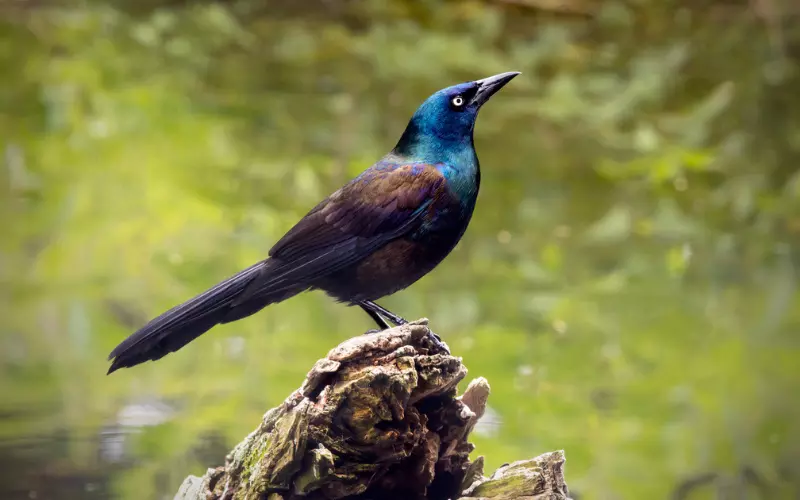
The common grackle bird has a long and fascinating evolutionary history. Millions of years ago, its ancestors were small, insect-eating birds. Over time, they faced various environmental changes, leading them to adapt and evolve into the common grackle we know today.
During the Ice Age, the common grackle’s ancestors had to find new food sources due to the freezing temperatures and lack of insects. They began eating berries, seeds, and small animals like frogs and mice. This change in diet helped them survive and thrive in different environments.
As the climate changed, some common grackles migrated to new areas. This led to the development of different bird subspecies, each suited to the specific conditions of their habitat. Some subspecies grew larger or smaller, while others developed unique beak shapes or colour variations to help them find food or attract mates.
Today, common grackles can be found in many parts of North America. They have evolved to be adaptable and resourceful, feeding on a wide variety of foods and nesting in different types of habitats. Their ability to survive and adapt throughout history is a testament to the incredible process of evolution, where species gradually change and adapt to their changing surroundings, ensuring their continued existence for generations to come.
Classification of Common Grackle
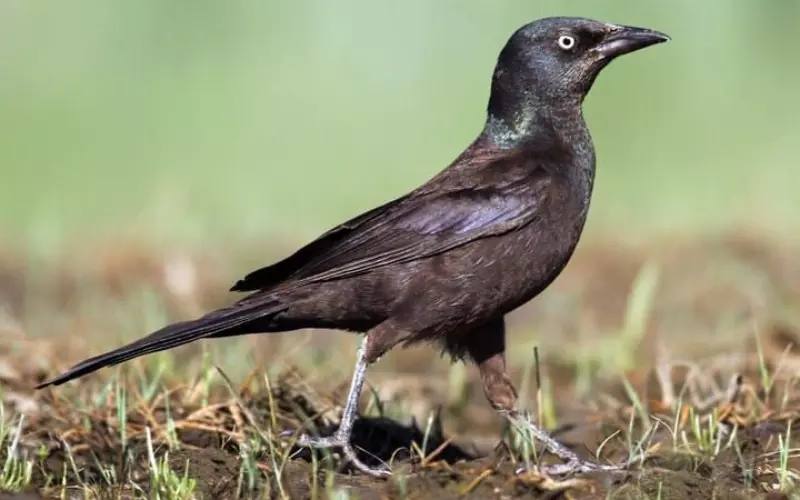
The Common Grackle is a type of bird that belongs to the blackbird family known as the Icteridae family. It is scientifically classified as Quiscalus quiscula. These birds are commonly found in North America, known for their glossy black plumage and bright yellow eyes. They also have long tails and strong beaks that help them in foraging for food.
Regarding their classification, the Common Grackle is part of the order Passeriformes, which includes over half of all bird species. Within this order, the grackle belongs to the family Icteridae, which consists of blackbirds, orioles, and meadowlarks. Further down the classification, the Common Grackle is part of the genus Quiscalus, which includes other blackbirds like the Great-tailed Grackle and Boat-tailed Grackle.
The Common Grackle species includes several subspecies that are found in different regions of North America. These subspecies have slight variations in appearance and behaviour. For example, the Greater Antillean Grackle, a subspecies of the Common Grackle, is found in the Caribbean islands. It has a smaller body size than the mainland Common Grackle and a more restricted range.
The Common Grackle is a bird that falls under the blackbird family and is scientifically classified as Quiscalus quiscula. It belongs to the order Passeriformes and the family Icteridae. This species has several subspecies, each with its unique characteristics and distribution. These birds are known for their black plumage, yellow eyes, and distinctive foraging habits.
Different Types of Common Grackle
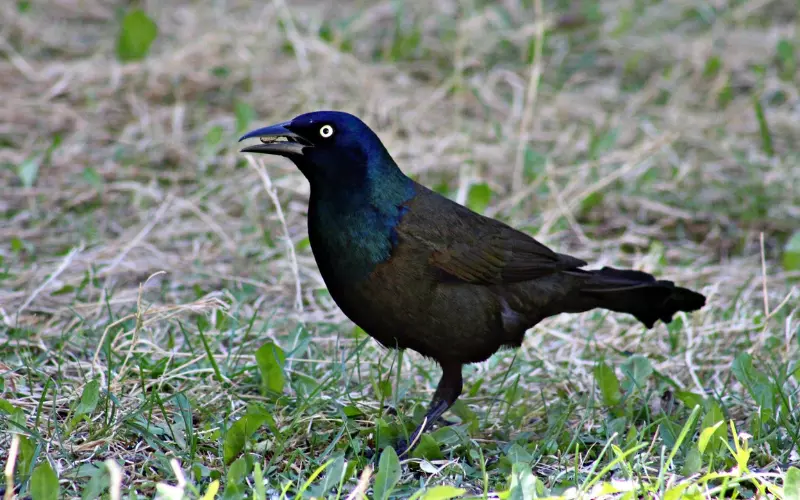
1. Great-tailed Grackle: The Great-tailed Grackle is known for its long, sleek tail and glossy black feathers. It is found in open fields and urban areas, often gathering in large flocks. They eat various foods, including insects, fruits, and grains.
2. Boat-tailed Grackle: The Boat-tailed Grackle is a large bird with a long, keel-shaped tail. They are commonly found near marshes, swamps, and coastal areas. These birds have a distinctive call and feed on various foods, including insects, seeds, and small vertebrates.
3. Common Grackle: The Common Grackle is a medium-sized bird with iridescent black feathers that can appear blue or purple in particular light. They are found in various habitats, including woodlands, grasslands, and urban areas. They are known for raiding bird feeders and nesting in trees.
4. Rusty Blackbird: The Rusty Blackbird is a small blackbird with rusty-colored feathers on its wings. They breed in northern North America and migrate south for the winter. They are primarily insectivorous but also eat berries and seeds.
5. Bronzed Cowbird: The Bronzed Cowbird is a medium-sized bird with glossy black feathers. They are parasitic birds, meaning they lay their eggs in the nests of other bird species. They are often found near cattle and other large mammals, hence their name.
6. Red-winged Blackbird: The Red-winged Blackbird is a medium-sized blackbird with red and yellow shoulder patches on males. They are common throughout North America and are usually found near wetlands and marshes. They eat insects, seeds, and berries.
7. Brewer’s Blackbird: The Brewer’s Blackbird is a medium-sized blackbird with a slightly iridescent sheen on its feathers. They are found in open habitats such as fields, meadows, and parking lots. They eat various foods, including insects, seeds, fruits, and garbage.
8. Yellow-headed Blackbird: The Yellow-headed Blackbird is a medium-sized blackbird with a striking yellow head and black body. They breed in marshes and wetlands of western North America. They primarily feed on insects and seeds.
9. Shiny Cowbird: The Shiny Cowbird is a small blackbird with glossy black feathers. They are native to South America but have expanded their range northwards. They are brood parasites, meaning they lay their eggs in the nests of other bird species.
10. Slender-billed Grackle: The Slender-billed Grackle is a medium-sized bird with a slender, slightly decurved bill. They are found in Central and South America. They primarily eat fruits and insects but consume nectar and occasionally steal food from other birds.
Geographical Presence of Common Grackle
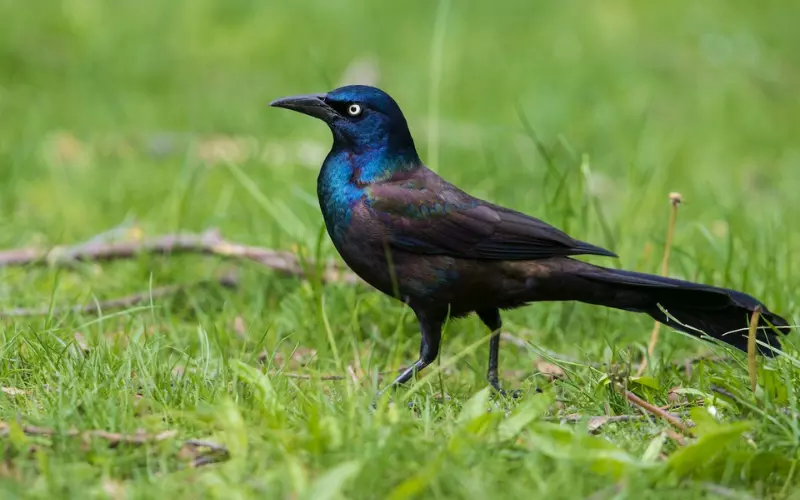
The Common Grackle bird is found in many regions of North America, including the United States, Canada, and parts of Mexico. They can be seen in various habitats, such as woodlands, meadows, suburban areas, and urban environments. These birds are known for their distinctive glossy black feathers and yellow eyes.
However, Common Grackles are not found in other parts of the world, such as Europe, Asia, Africa, or Australia. They are mainly restricted to the North American continent. Their natural habitat and food sources are specific to this region. The Common Grackle’s diet primarily consists of insects, fruits, grains, and even small animals, which are abundant in North America.
The Common Grackle bird can be found in many regions of North America, including the United States, Canada, and parts of Mexico. They are commonly seen in woodlands, meadows, suburban areas, and urban environments. However, they are not found in other parts of the world, like Europe, Asia, Africa, or Australia, as their habitat and food sources are specific to the North American continent.
Scientific Name of Common Grackle
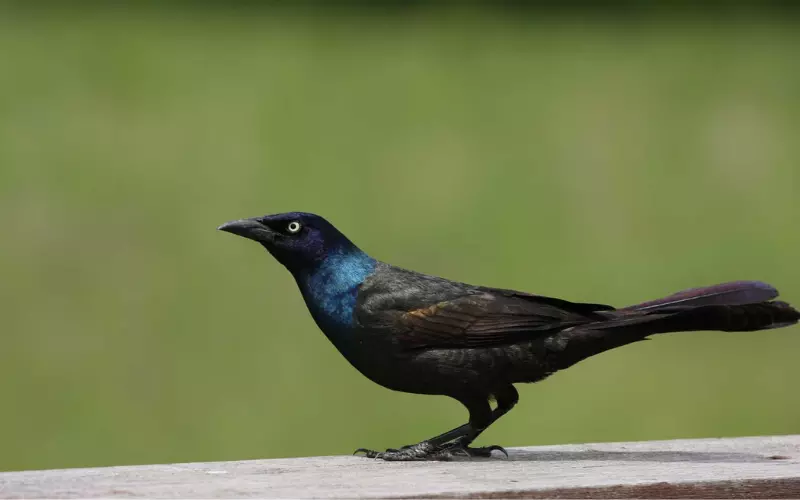
The scientific name of the common grackle bird is Quiscalus quiscula. This bird belongs to the family Icteridae and is native to North America. Common grackles are medium-sized birds known for glossy black feathers and bright yellow eyes.
Common grackles can be found in various habitats, such as urban areas, forests, and wetlands. They are highly adaptable and are often seen foraging for food on the ground or in shallow water. These birds have a diverse diet, which includes insects, small vertebrates, seeds, and grains.
In terms of behaviour, common grackles are known for their loud and raucous calls, which can sometimes resemble the sounds of a rusty gate. They are also highly social birds and can form large flocks, especially in winter. During the breeding season, male grackles perform elaborate displays to attract females, including spreading their wings and tail feathers to show off their shiny plumage.
The common grackle bird, scientifically known as Quiscalus quiscula, is a medium-sized bird native to North America. It is easily recognized by its glossy black feathers and yellow eyes. Common grackles are adaptable birds in various habitats and have diverse feeding habits. They are known for their loud calls and ability to form large flocks. Male grackles perform elaborate displays to attract females during the breeding season.
Diet of Common Grackle
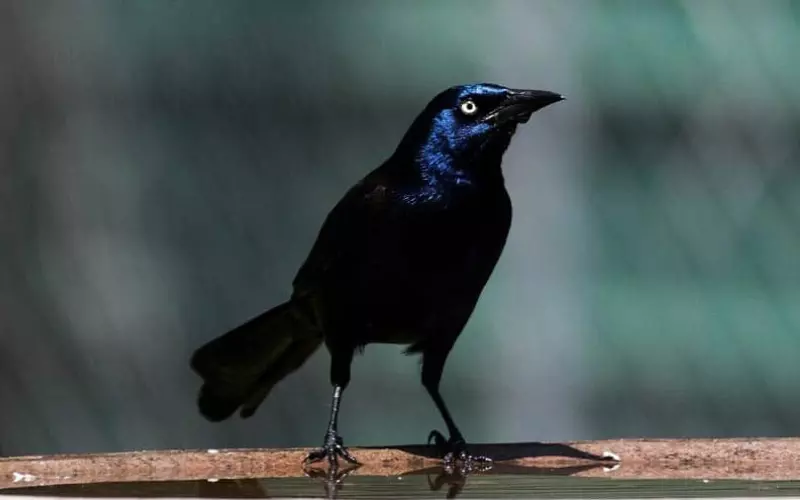
The common grackle bird has a diverse and varied diet. It loves to eat both insects and fruits. In the summer, these birds feast on various insects, such as grasshoppers, beetles, caterpillars, and spiders. They use their sharp beaks to catch and eat these tiny creatures. This helps keep the insect population in check and maintains the balance of nature.
Apart from insects, common grackles also enjoy eating fruits and seeds. They can often be seen perching on trees and gobbling up berries, cherries, grapes, and apples. They also feed on grains such as corn and oats. These birds are attracted to these food sources because they are easy to find and provide the energy they need.
Common grackles are opportunistic feeders and will even scavenge for food in garbage cans and picnic areas. They are not picky eaters and will eat whatever is available to them. This adaptability helps them survive in different environments, whether in cities, suburbs, or the countryside.
The diet of a common grackle bird consists of insects, fruits, seeds, and even leftovers from humans. They play an essential role in keeping the insect population in control and help disperse seeds by eating fruits. These birds are not fussy eaters and can survive by adapting to various food sources.
Locomotion of Common Grackle
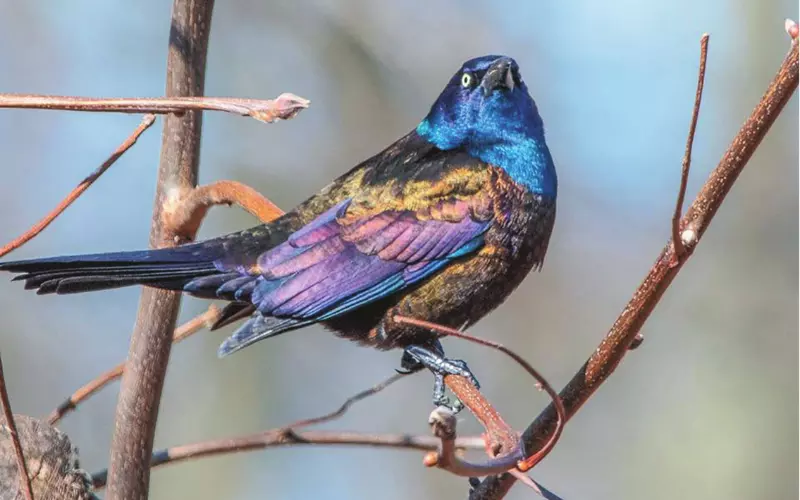
The Common Grackle bird has a unique way of moving around called locomotion. They use their strong wings to fly from one place to another. Their wings flap up and down quickly, giving them the power to soar through the air.
The Common Grackle can walk or hop on the ground when it is not flying. It has long legs help it take big steps as it moves forward. Sometimes, it can even run on the ground for short distances. The Common Grackle bird is versatile in its locomotion, allowing it to quickly navigate different environments and find food.
Social and Sexual Behaviour of Common Grackle
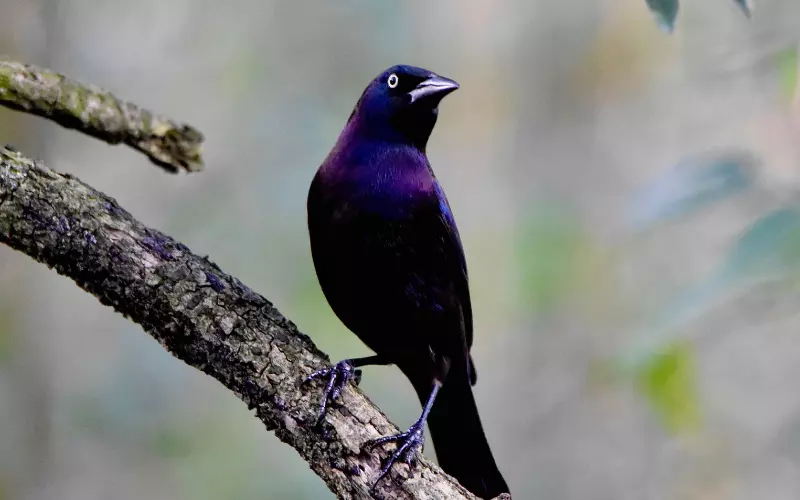
Common grackle birds are known for their interesting social and sexual behaviours. These beautiful birds usually live in large groups called flocks. Within these flocks, they interact and communicate with each other using various calls and vocalizations. They are very social creatures and often gather in loud and energetic groups.
Regarding sexual behaviour, male common grackles often display a unique courtship ritual to attract females. They puff up their feathers, spread their tails, and produce loud, high-pitched calls to show their attractiveness. The female grackles then choose their mate based on their performance and overall display. This courtship behaviour is a fascinating sight to witness.
Furthermore, common grackles also have a hierarchical social structure within their flocks. This means there is a clear dominance hierarchy, where some birds have higher status, and others have lower status. The higher-ranking birds often get better access to food resources and mate with more females. They establish dominance through aggressive displays, such as squawking loudly and puffing up their feathers.
Common grackle birds have intriguing social and sexual behaviours. They live together in flocks and communicate with each other using various calls. During courtship, male grackles put on impressive displays to attract females. Additionally, they have a clear hierarchy within their flocks, with dominant birds having more privileges. Overall, observing the social and sexual behaviour of common grackles can be a fascinating experience.
Reproduction and Lifecycle of Common Grackle
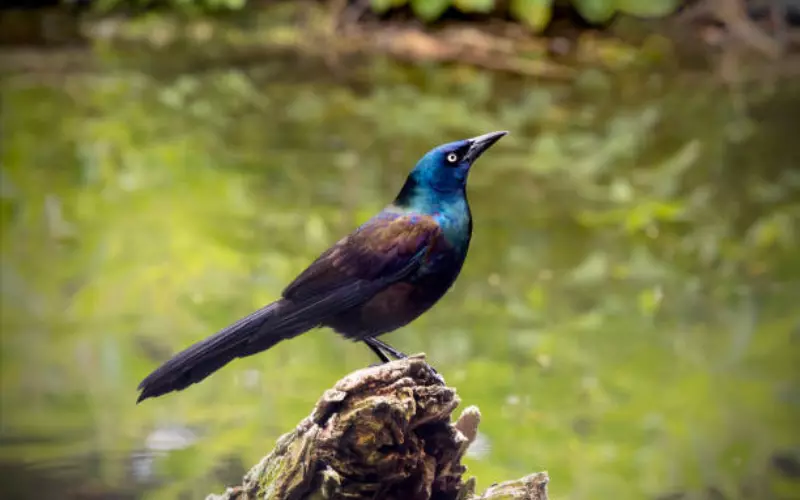
Common grackles are birds known for their distinctive appearance and unique behaviours. These birds reproduce and live a life cycle influenced by their natural surroundings. Let’s explore their reproduction and life cycle in simpler terms.
To begin with, common grackles reproduce by mating. During the breeding season, male grackles display black feathers, which shine with a bluish or purplish tint. They make loud calls or songs to attract females. Once a female chooses her mate, they build a nest together. Grackles usually construct their nests in dense trees or shrubs using twigs, grass, and mud. The female lays a clutch of around 4-7 eggs, and both parents take turns incubating them for about 12-14 days until they hatch.
Once the eggs hatch, the parents feed and care for the young grackles. The chicks are born naked and helpless but quickly develop feathers and proliferate. The parents feed the chicks a diet consisting mainly of insects and fruits. After around 2-3 weeks, the chicks leave the nest but remain close to their parents, who continue to provide them with food. As the young birds become more independent, they learn essential skills like foraging for food and avoiding predators.
As the seasons change, the adult common grackles and their offspring form large flocks. These flocks often travel long distances, migrating to areas with more favourable conditions for survival. Grackles have a relatively short life span, usually living for about 3-7 years. Throughout their lives, they contribute to the balance of nature by dispersing seeds and controlling insect populations. Their reproduction and life cycle are essential in maintaining biodiversity in their habitats.
Threats to Common Grackle

The Common Grackle bird faces several threats that can harm its population. One big threat comes from the loss of its natural habitat. Many forests and wetlands, which are the homes of the Common Grackle, are being destroyed or turned into cities. This means that the Grackles have less space to live in and find food, which can lead to a decline in their numbers.
Another threat to the Common Grackle is pollution. Pollution can come from many sources, such as factories and cars. When pollution gets into the air and water, it can harm the birds and their eggs. It can affect their ability to find food and reproduce successfully. Pollution is a big problem for many animals, including the Common Grackle.
Lastly, the Common Grackle also faces threats from predators. Some animals, like cats and snakes, like to eat the eggs and chicks of the Grackles. This can be a big problem because it reduces the number of birds that can grow up and continue the population. When there are too many predators around, it can be difficult for the Common Grackle to survive.
Overall, the Common Grackle bird faces threats from losing its habitat, pollution, and predators. These threats can harm the birds and cause a decline in their population. We need to take care of our environment and be mindful of how our actions can affect the animals that share our world.
The population of Common Grackle

The population of the common grackle bird is estimated to be around 73 million individuals. These birds are widely spread throughout North America, from Canada to the southern United States. They are adaptable and can live in various habitats, including forests, farmlands, and urban areas. The common grackle is known for its shiny black feathers and yellow eyes.
Sadly, if the common grackle bird were to go extinct, it would mean that no more of these birds are left in the world. Extinction happens when a species disappears completely, usually due to habitat loss, pollution, or overhunting. Humans need to protect the common grackle bird and other animals to prevent their extinction.
To help prevent extinction, we can conserve their habitats, avoid harmful pesticides that can harm these birds, and promote awareness about their importance in our ecosystems. We must value and protect all living creatures, like the common grackle bird, as they play an essential role in maintaining the balance of nature.
Conclusion
To sum up, the Common Grackle is a fascinating bird with a long history and interesting facts. They are known for their large size and shiny black feathers, which can shimmer with hues of blue and purple. Their loud and raucous calls can be heard in various habitats across North America, from cities to wetlands.
Regarding classification, the Common Grackle belongs to the Animalia kingdom, Aves class, and Icteridae family. They are closely related to blackbirds and orioles. These birds are highly adaptable and thrive in urban environments, often seen foraging for food in parks and gardens.
The Common Grackle has played a significant role in Native American folklore and has been celebrated for its intelligence and resourcefulness. Despite being considered a nuisance by some due to their large population and sometimes aggressive behaviour, these birds play a crucial role in our ecosystem by dispersing seeds and controlling insect populations.
Overall, the Common Grackle is a remarkable bird that deserves our admiration and respect. By learning more about these birds, we can appreciate the diversity and beauty of the animal kingdom and become more aware of the importance of protecting and preserving their habitats.
Frequently Asked Questions about Common Grackle (FAQ’s)
What is a common grackle bird?
The common grackle (Quiscalus quiscula) is a medium-sized blackbird native to North America.
What is the size of a common grackle?
Common grackles measure around 12-13 inches, with a wingspan of approximately 17-18 inches.
How can common grackles be identified?
Common grackles are easily identified by their glossy black plumage, yellow eyes, and long tails.
Where can common grackles be found?
Common grackles are found throughout North America, from southern Canada to central Mexico.
Are common grackles migratory birds?
Yes, common grackles are known to be migratory birds, with some populations migrating south in the winter.
What is the diet of a common grackle?
Common grackles have an omnivorous diet, feeding on fruits, grains, insects, small vertebrates, and bird eggs.
How do common grackles communicate?
Common grackles communicate through various sounds, including calls, songs, and vocalizations.
Do common grackles build nests?
Common grackles build large, bulky nests made of twigs, grass, and mud, often placed in trees or shrubs near water.
What is the breeding season of common grackles?
Common grackles typically breed from March to July, depending on their location.
How many eggs do common grackles lay?
Common grackles usually lay 3-7 eggs per clutch.
How long does it take for ordinary grackle eggs to hatch?
It takes about 14 days for ordinary grackle eggs to hatch after they are laid.
How long do common grackles live?
Common grackles have an average lifespan of around 5 years in the wild but can live up to 17 years in captivity.
Can common grackles imitate sounds?
Yes, common grackles are known for their ability to mimic the sounds of other birds and even mechanical noises.
Are common grackles harmful to crops?
Common grackles can be considered agricultural pests as they may damage crops and raid gardens for food.
Do common grackles have any predators?
Common grackles have a few natural predators, such as hawks, owls, raccoons, and snakes.

Hey there, I’m Kristen Haudenschild! I’m like a superhero for animals and people.
I work as a Dependable Hard Working Supervisor, which means I help both people and animals grow and learn. I did my school at OdySea Aquarium and Georgia Southern University in Tempe, Arizona. That’s where I learned all about animals, and guess what? I’m fascinated by them!
I even write cool articles about animals. My job history includes being an Animal Trainer and a Marine Mammal Trainer II at OdySea Aquarium. I’ve also been a Senior Animal Care Specialist and an Animal Care Specialist 2.
I love exploring animals and am always ready to help others learn more about them. So, if you ever need info about animals, give me a shout!

